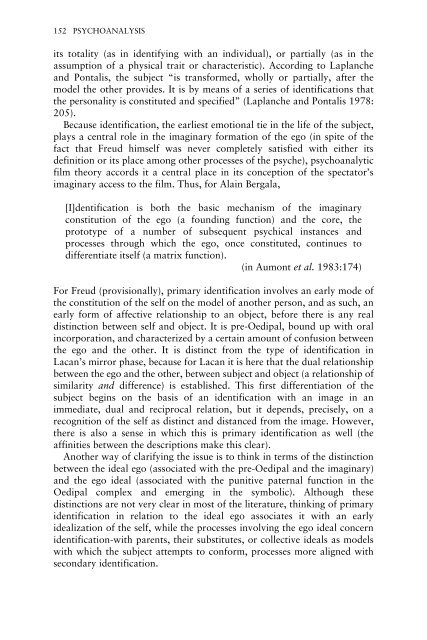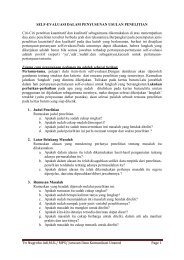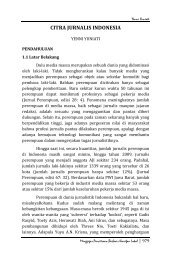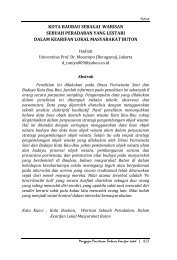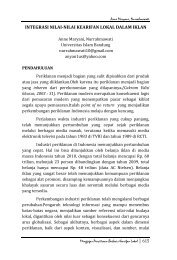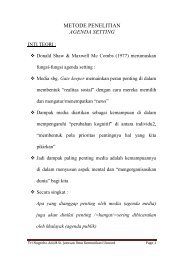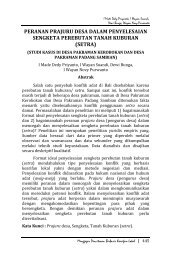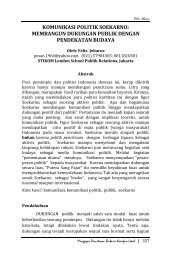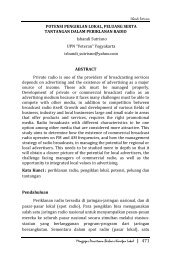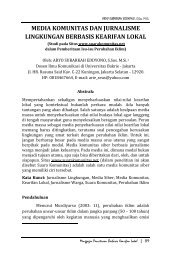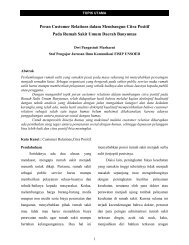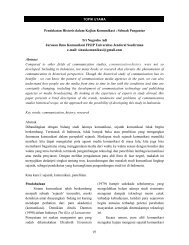New Vocabularies in Film Semiotics
New Vocabularies in Film Semiotics
New Vocabularies in Film Semiotics
You also want an ePaper? Increase the reach of your titles
YUMPU automatically turns print PDFs into web optimized ePapers that Google loves.
152 PSYCHOANALYSIS<br />
its totality (as <strong>in</strong> identify<strong>in</strong>g with an <strong>in</strong>dividual), or partially (as <strong>in</strong> the<br />
assumption of a physical trait or characteristic). Accord<strong>in</strong>g to Laplanche<br />
and Pontalis, the subject “is transformed, wholly or partially, after the<br />
model the other provides. It is by means of a series of identifications that<br />
the personality is constituted and specified” (Laplanche and Pontalis 1978:<br />
205).<br />
Because identification, the earliest emotional tie <strong>in</strong> the life of the subject,<br />
plays a central role <strong>in</strong> the imag<strong>in</strong>ary formation of the ego (<strong>in</strong> spite of the<br />
fact that Freud himself was never completely satisfied with either its<br />
def<strong>in</strong>ition or its place among other processes of the psyche), psychoanalytic<br />
film theory accords it a central place <strong>in</strong> its conception of the spectator’s<br />
imag<strong>in</strong>ary access to the film. Thus, for Ala<strong>in</strong> Bergala,<br />
[I]dentification is both the basic mechanism of the imag<strong>in</strong>ary<br />
constitution of the ego (a found<strong>in</strong>g function) and the core, the<br />
prototype of a number of subsequent psychical <strong>in</strong>stances and<br />
processes through which the ego, once constituted, cont<strong>in</strong>ues to<br />
differentiate itself (a matrix function).<br />
(<strong>in</strong> Aumont et al. 1983:174)<br />
For Freud (provisionally), primary identification <strong>in</strong>volves an early mode of<br />
the constitution of the self on the model of another person, and as such, an<br />
early form of affective relationship to an object, before there is any real<br />
dist<strong>in</strong>ction between self and object. It is pre-Oedipal, bound up with oral<br />
<strong>in</strong>corporation, and characterized by a certa<strong>in</strong> amount of confusion between<br />
the ego and the other. It is dist<strong>in</strong>ct from the type of identification <strong>in</strong><br />
Lacan’s mirror phase, because for Lacan it is here that the dual relationship<br />
between the ego and the other, between subject and object (a relationship of<br />
similarity and difference) is established. This first differentiation of the<br />
subject beg<strong>in</strong>s on the basis of an identification with an image <strong>in</strong> an<br />
immediate, dual and reciprocal relation, but it depends, precisely, on a<br />
recognition of the self as dist<strong>in</strong>ct and distanced from the image. However,<br />
there is also a sense <strong>in</strong> which this is primary identification as well (the<br />
aff<strong>in</strong>ities between the descriptions make this clear).<br />
Another way of clarify<strong>in</strong>g the issue is to th<strong>in</strong>k <strong>in</strong> terms of the dist<strong>in</strong>ction<br />
between the ideal ego (associated with the pre-Oedipal and the imag<strong>in</strong>ary)<br />
and the ego ideal (associated with the punitive paternal function <strong>in</strong> the<br />
Oedipal complex and emerg<strong>in</strong>g <strong>in</strong> the symbolic). Although these<br />
dist<strong>in</strong>ctions are not very clear <strong>in</strong> most of the literature, th<strong>in</strong>k<strong>in</strong>g of primary<br />
identification <strong>in</strong> relation to the ideal ego associates it with an early<br />
idealization of the self, while the processes <strong>in</strong>volv<strong>in</strong>g the ego ideal concern<br />
identification-with parents, their substitutes, or collective ideals as models<br />
with which the subject attempts to conform, processes more aligned with<br />
secondary identification.


